Abstract
A soluble form of complement receptor 2 (sCR2) is found in normal human serum. Amounts present are about 30-90 ng/ml, which is of the same order as reported for soluble CR1. Although B cells express surface CR2 and are the main peripheral blood source of sCR2 they do not appear to be the major tissue source of serum sCR2. Serum levels of sCR2 of patients with hypogammaglobulinaemia were not significantly different from those of normal individuals even in the case of two brothers with Bruton's X-linked agammaglobulinaemia (XLA) lacking (CD19+) B cells. On gel filtration through Sephacryl S-300 the sCR2 from XLA serum behaved exactly like sCR2 from normal serum or sCR2 affinity purified from cell supernates of a B lymphoblastoid line or from the T-ALL line MOLT-4. In all cases a single peak appeared at the same point in the chromatogram. Possible alternative sources of serum sCR2 are follicular dendritic cells (FDC) which are known to express CR2 strongly and T6+ lymphocytes within the thymus. Peripheral T cells from adults have not been reported to express CR2. However, investigation showed that cells from the Bruton's XLA cases produced small amounts of sCR2 in culture and although no CD21 was detected on the surface of the mononuclear cells by flow cytometry, the more sensitive direct antibody rosette test readily detected CD21. Further studies showed that non-B cells from control samples of cord blood or blood of young children also weakly expressed CD21.
Full text
PDF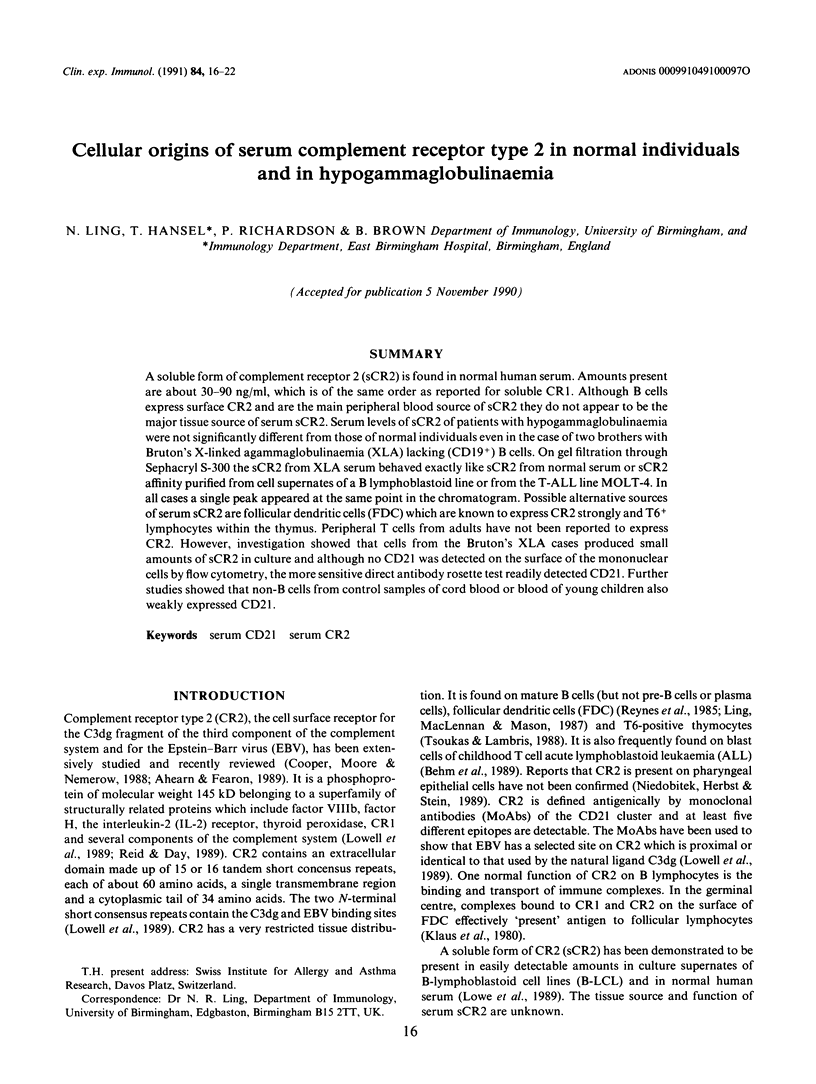
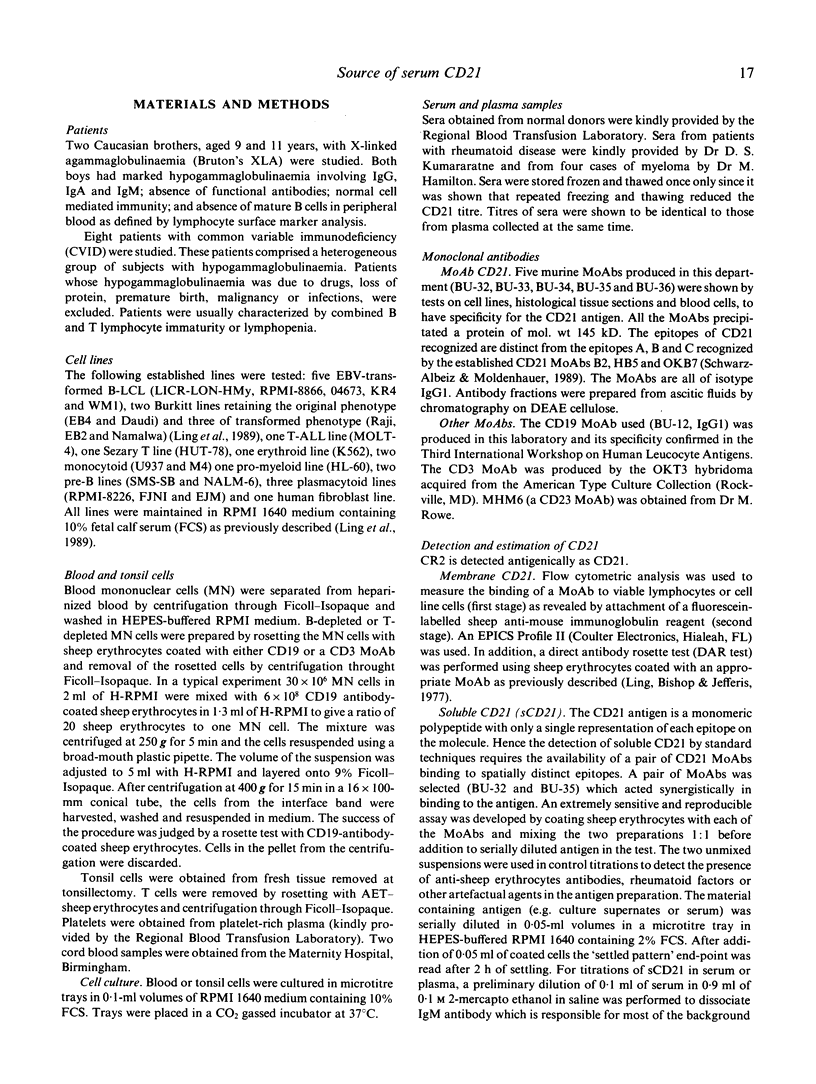
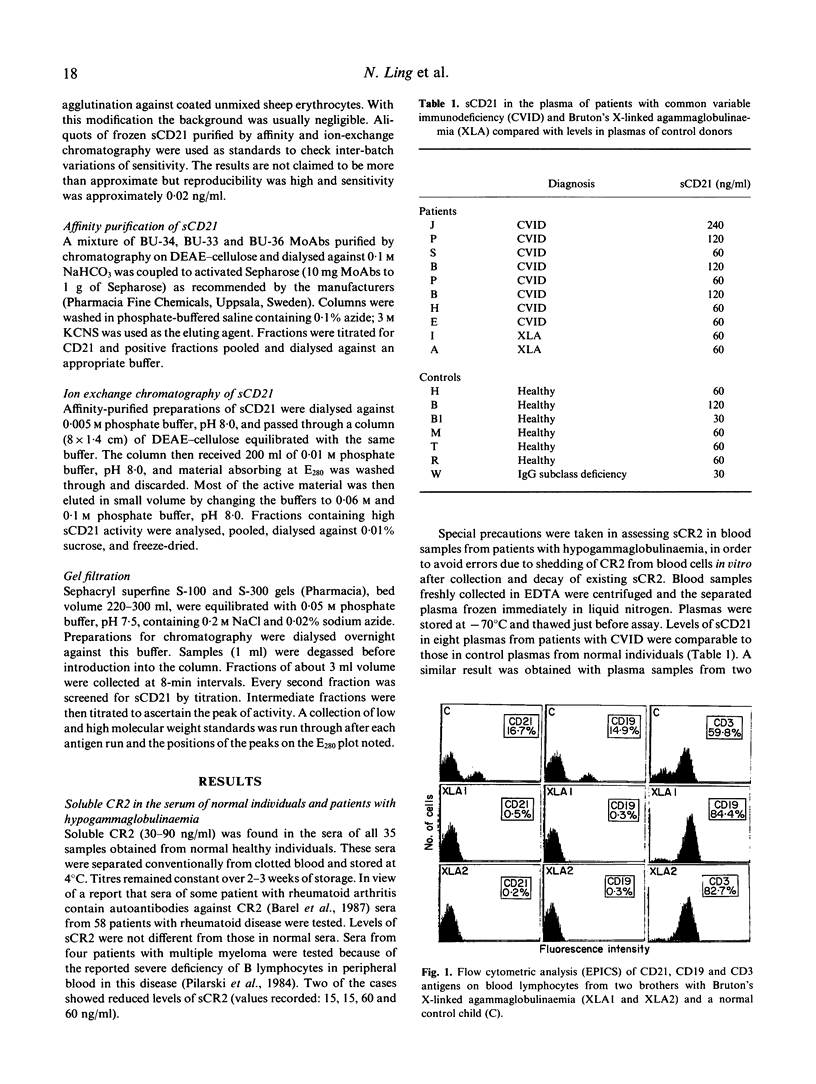
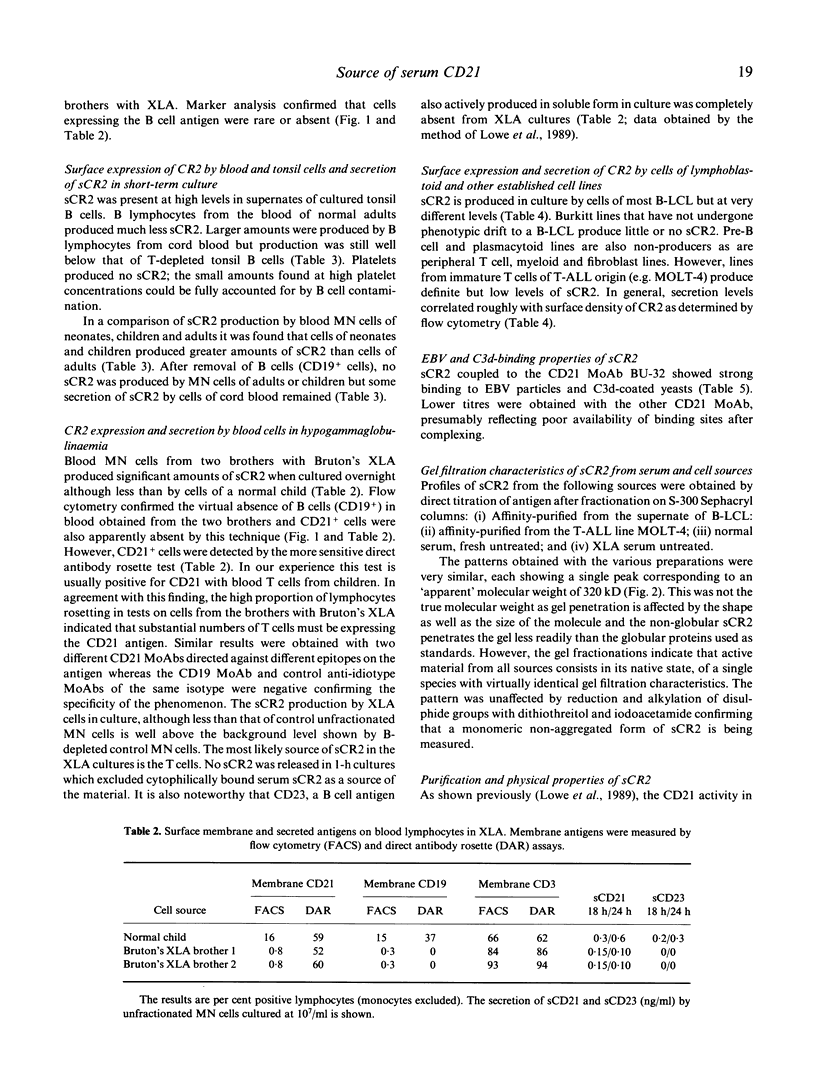
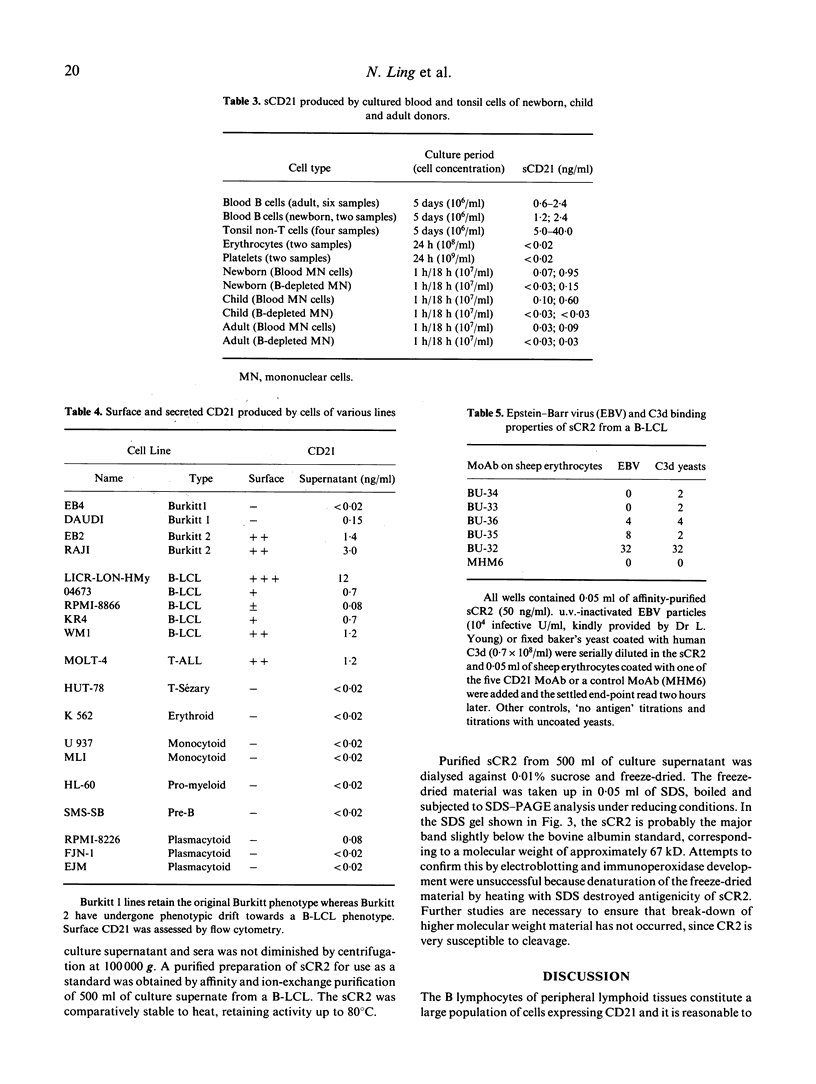
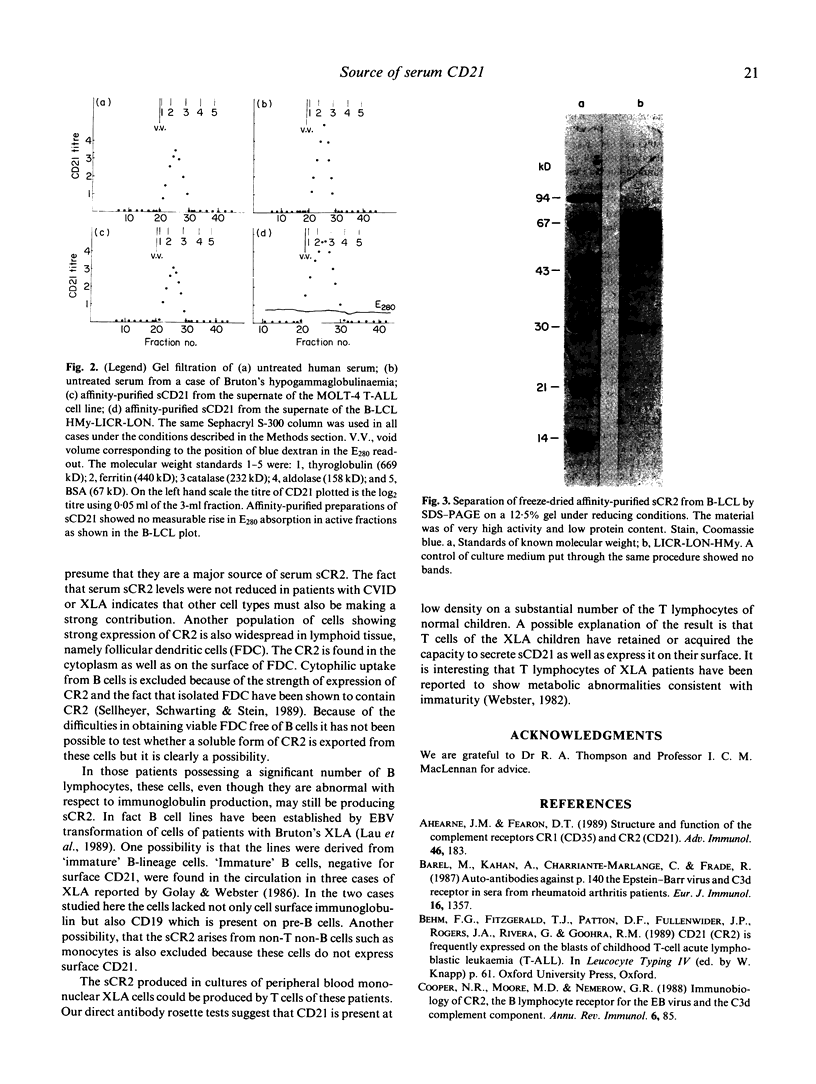
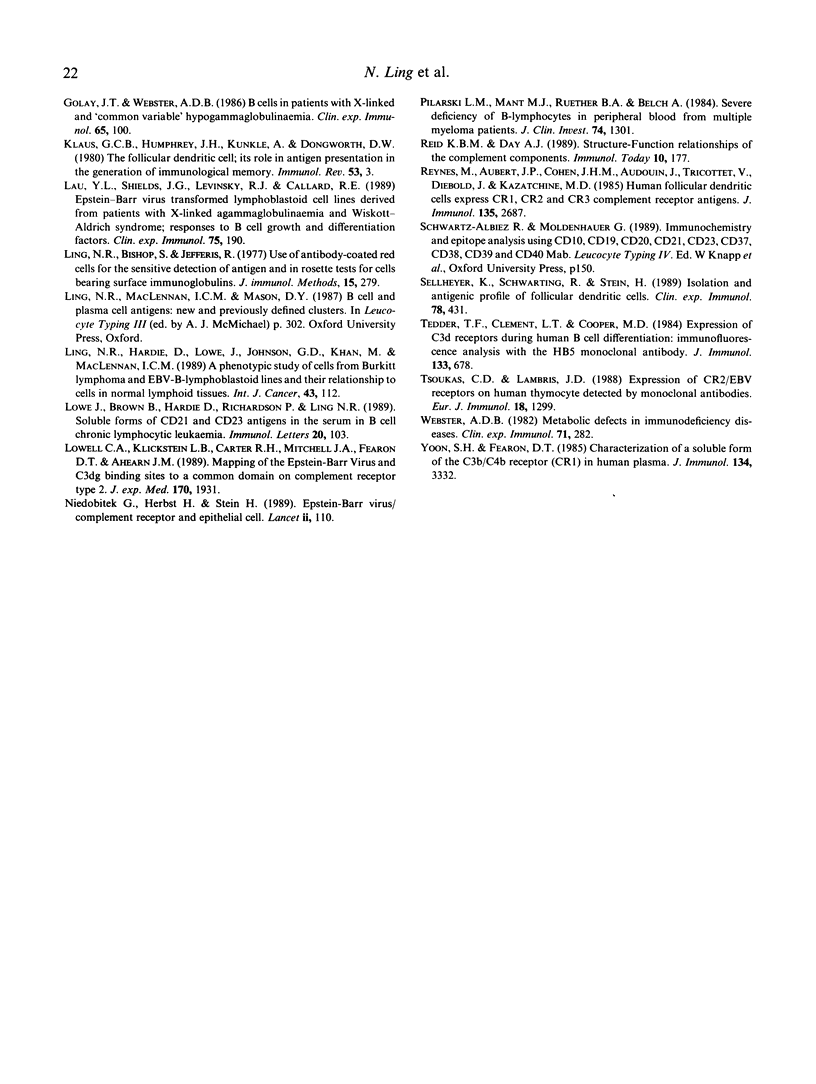
Images in this article
Selected References
These references are in PubMed. This may not be the complete list of references from this article.
- Ahearn J. M., Fearon D. T. Structure and function of the complement receptors, CR1 (CD35) and CR2 (CD21). Adv Immunol. 1989;46:183–219. doi: 10.1016/s0065-2776(08)60654-9. [DOI] [PubMed] [Google Scholar]
- Barel M., Kahan A., Charriaut-Marlangue C., Kahan A., Frade R. Autoantibodies against gp140, the Epstein-Barr virus and C3d receptor in sera from rheumatoid arthritis patients. Eur J Immunol. 1986 Nov;16(11):1357–1361. doi: 10.1002/eji.1830161108. [DOI] [PubMed] [Google Scholar]
- Cooper N. R., Moore M. D., Nemerow G. R. Immunobiology of CR2, the B lymphocyte receptor for Epstein-Barr virus and the C3d complement fragment. Annu Rev Immunol. 1988;6:85–113. doi: 10.1146/annurev.iy.06.040188.000505. [DOI] [PubMed] [Google Scholar]
- Golay J. T., Webster A. D. B cells in patients with X-linked and 'common variable' hypogammaglobulinaemia. Clin Exp Immunol. 1986 Jul;65(1):100–104. [PMC free article] [PubMed] [Google Scholar]
- Klaus G. G., Humphrey J. H., Kunkl A., Dongworth D. W. The follicular dendritic cell: its role in antigen presentation in the generation of immunological memory. Immunol Rev. 1980;53:3–28. doi: 10.1111/j.1600-065x.1980.tb01038.x. [DOI] [PubMed] [Google Scholar]
- Lau Y. L., Shields J. G., Levinsky R. J., Callard R. E. Epstein-Barr-virus-transformed lymphoblastoid cell lines derived from patients with X-linked agammaglobulinaemia and Wiskott-Aldrich syndrome: responses to B cell growth and differentiation factors. Clin Exp Immunol. 1989 Feb;75(2):190–195. [PMC free article] [PubMed] [Google Scholar]
- Ling N. R., Bishop S., Jefferis Use of antibody-coated red cells for the sensitive detection of antigen and in rosette tests for cells bearing surface immunoglobulins. J Immunol Methods. 1977;15(3):279–289. doi: 10.1016/0022-1759(77)90065-5. [DOI] [PubMed] [Google Scholar]
- Ling N. R., Hardie D., Lowe J., Johnson G. D., Khan M., MacLennan I. C. A phenotypic study of cells from Burkitt lymphoma and EBV-B-lymphoblastoid lines and their relationship to cells in normal lymphoid tissues. Int J Cancer. 1989 Jan 15;43(1):112–118. doi: 10.1002/ijc.2910430122. [DOI] [PubMed] [Google Scholar]
- Lowe J., Brown B., Hardie D., Richardson P., Ling N. Soluble forms of CD21 and CD23 antigens in the serum in B cell chronic lymphocytic leukaemia. Immunol Lett. 1989 Jan 31;20(2):103–109. doi: 10.1016/0165-2478(89)90093-x. [DOI] [PubMed] [Google Scholar]
- Lowell C. A., Klickstein L. B., Carter R. H., Mitchell J. A., Fearon D. T., Ahearn J. M. Mapping of the Epstein-Barr virus and C3dg binding sites to a common domain on complement receptor type 2. J Exp Med. 1989 Dec 1;170(6):1931–1946. doi: 10.1084/jem.170.6.1931. [DOI] [PMC free article] [PubMed] [Google Scholar]
- Niedobitek G., Herbst H., Stein H. Epstein-Barr virus/complement receptor and epithelial cells. Lancet. 1989 Jul 8;2(8654):110–110. doi: 10.1016/s0140-6736(89)90357-7. [DOI] [PubMed] [Google Scholar]
- Pilarski L. M., Mant M. J., Ruether B. A., Belch A. Severe deficiency of B lymphocytes in peripheral blood from multiple myeloma patients. J Clin Invest. 1984 Oct;74(4):1301–1306. doi: 10.1172/JCI111540. [DOI] [PMC free article] [PubMed] [Google Scholar]
- Reid K. B., Day A. J. Structure-function relationships of the complement components. Immunol Today. 1989 Jun;10(6):177–180. doi: 10.1016/0167-5699(89)90317-4. [DOI] [PubMed] [Google Scholar]
- Reynes M., Aubert J. P., Cohen J. H., Audouin J., Tricottet V., Diebold J., Kazatchkine M. D. Human follicular dendritic cells express CR1, CR2, and CR3 complement receptor antigens. J Immunol. 1985 Oct;135(4):2687–2694. [PubMed] [Google Scholar]
- Sellheyer K., Schwarting R., Stein H. Isolation and antigenic profile of follicular dendritic cells. Clin Exp Immunol. 1989 Dec;78(3):431–436. [PMC free article] [PubMed] [Google Scholar]
- Tedder T. F., Clement L. T., Cooper M. D. Expression of C3d receptors during human B cell differentiation: immunofluorescence analysis with the HB-5 monoclonal antibody. J Immunol. 1984 Aug;133(2):678–683. [PubMed] [Google Scholar]
- Tsoukas C. D., Lambris J. D. Expression of CR2/EBV receptors on human thymocytes detected by monoclonal antibodies. Eur J Immunol. 1988 Aug;18(8):1299–1302. doi: 10.1002/eji.1830180823. [DOI] [PubMed] [Google Scholar]
- Yoon S. H., Fearon D. T. Characterization of a soluble form of the C3b/C4b receptor (CR1) in human plasma. J Immunol. 1985 May;134(5):3332–3338. [PubMed] [Google Scholar]



